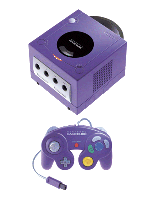
After many months of speculation and anticipation, Nintendo's upcoming next-generation system, previously known to the public as "Project Dolphin," has been formally announced. The system's new and (most probably) final name, Nintendo Gamecube, as well as plenty of other details on the console were finally revealed at Nintendo's annual "Spaceworld" gaming show held in Tokyo.
The Gamecube had a fantastic showing at Nintendo's Spaceworld. The system was shown off using marvelous technical demos featuring such Nintendo characters as Mario, Luigi, Link, and Samus Aran, as well as popular franchises like Star Wars and Pokémon. Nintendo.com's Spaceworld section stresses that these technical demos do not necessarily imply that these are actual games in development. However, anxious gamers should certainly keep their fingers crossed, as some of these demos, more likely than not, may turn out to be actual Gamecube games after all.
For our readers interested in the technical aspects of Nintendo's new console, following is Nintendo's official Gamecube hardware specification list:
| Official Name |
NINTENDO GAMECUBE |
| MPU("Microprocessor Unit")* |
IBM Power PC "Gekko" |
| Manufacturing Process |
0.18 microns Copper Wire Technology |
| Clock Frequency |
405 MHz |
| CPU Capacity |
925 Dmips (Dhrystone 2.1) |
| Internal Data Precision |
32bit Integer & 64bit Floating-point |
| External Bus Bandwidth |
1.6GB/second(Peak) (32bit address, 64bit data bus 202.5MHz) |
| Internal Cache |
L1: Instruction 32KB, Data 32KB (8 way) L2: 256KB (2 way) |
| System LSI |
"Flipper" |
| Manufacturing Process |
0.18 microns NEC Embedded DRAM Process |
| Clock Frequency |
202.5MHz |
| Embedded Frame Buffer |
Approx. 2MB Sustainable Latency : 5ns (1T-SRAM) |
| Embedded Texture Cache |
Approx. 1MB
Sustainable Latency : 5ns (1T-SRAM) |
| Texture Read Bandwidth |
12.8GB/second (Peak) |
| Main Memory Bandwidth |
3.2GB/second (Peak) |
| Color, Z Buffer |
Each is 24bits |
| Image Processing Function |
Fog, Subpixel Anti-aliasing, HW Light x8,
Alpha Blending, Virtual Texture Design,
Multi-texture Mapping/Bump/Environment
Mapping, MIPMAP, Bilinear Filtering,
Real-time Texture Decompression (S3TC), etc. |
| Other |
Real-time Decompression of Display List,
HW Motion Compensation Capability |
*The Gekko MPU integrates the power PC CPU into a custom, game-centric chip.
(The following sound related functions are all incorporated into the System LSI)
| Sound Processor |
Special 16bit DSP |
| Instruction Memory |
8KB RAM + 8KB ROM |
| Data Memory |
8KB RAM + 4KB ROM |
| Clock Frequency |
101.25 MHz |
| Maximum Number of Simultaneously Produced Sounds |
ADPCM: 64ch |
| Sampling Frequency |
48KHz |
| System Floating-point
Arithmetic Capability |
13.0GFLOPS (Peak)
(MPU, Geometry Engine, HW Lighting Total) |
| Actual Display Capability |
6 million to 12 million polygons/second (Display capability assuming actual game
with complexity model, texture, etc.) |
| System Main Memory |
24MB Sustainable Latency :
10ns or lower (1T-SRAM) |
| A-Memory |
16MB (100MHz DRAM) |
| Disc Drive |
CAV (Constant Angular Velocity) System Average Access Time Data Transfer Speed 16Mbps to 25Mbps 128ms |
| Media |
8cm NINTENDO GAMECUBE Disc based on Matsushita's Optical Disc Technology Approx. 1.5GB Capacity |
| Input/Output |
Controller Port x4
Digicard Slot x2
Analog AV Output x1
Digital AV Output x1
High-Speed Serial Port x2
High-speed Parallel Port x1 |
| Power Supply |
AC Adapter DC12V x 3.5A |
| Main Unit Dimensions |
150mm(W) x 110mm(H) x 161mm(D) |
The Gamecube is set to hit Japan in July 2001, with a North American release soon to follow in October 2001. Although rumors have been circulating the internet lately concerning the Gamecube's initial price at launch, no official word has been given as of yet. Stay tuned to RPGamer for all the big details concerning Nintendo's upcoming jump into the next generation of consoles.
|









